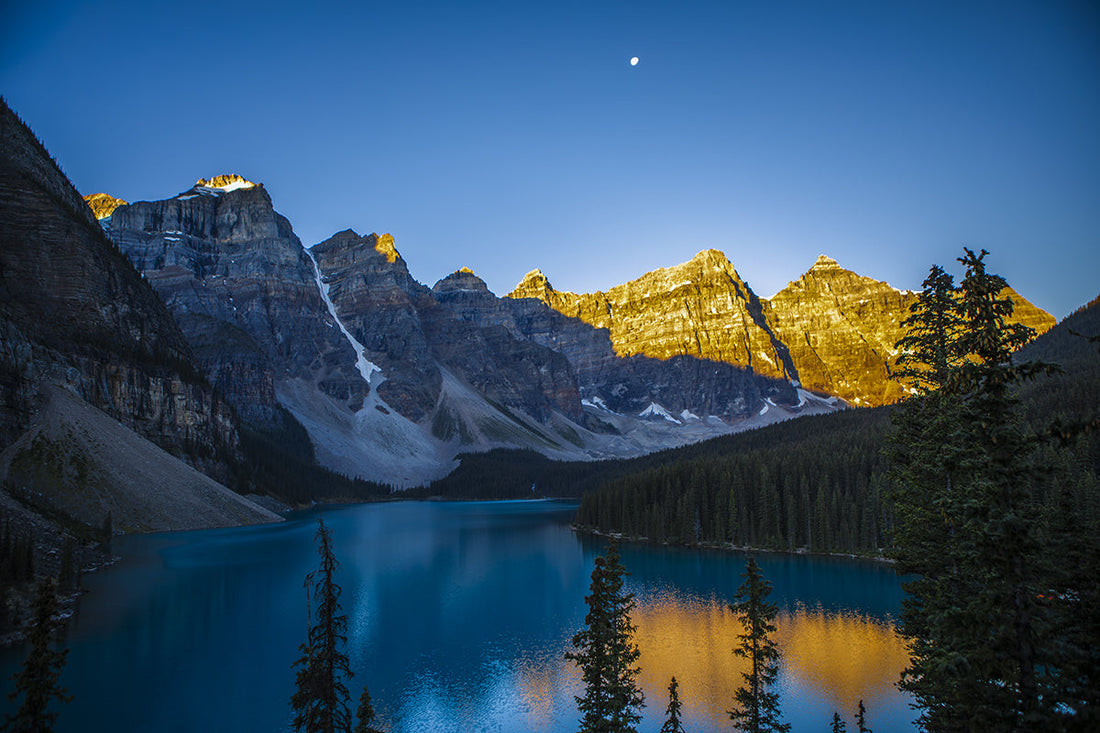
Moraine Lake Sunrise
This August, I returned to the Canadian Rockies for the first time in 36 years. The last time I visited was during the summer when I was 12, shortly after moving to Canada with my family. It was the very first Canadian adventure my father took us, and even as a child, I remember being completely awestruck by the sheer scale and beauty of the landscape. That memory stayed vivid in my heart all these years. So when I heard about the Canada Strong Pass, a new initiative from the Canadian government that made entry to national parks free and offered discounts on campgrounds from June 20 to September 2, 2025, I knew right away that this summer, I would return to the Rockies.
The Canadian Rockies lie in the neighbouring province of Alberta, just east of British Columbia where we live, and are part of a UNESCO World Heritage Site that includes Banff, Jasper, Yoho, and Kootenay National Parks, as well as three provincial parks. But even though Alberta is next door, it’s no short trip. It is about 850 kilometers one way, more than 10 hours of driving non-stop, plus a one-hour time difference between provinces. It reminded me just how massive Canada truly is. Over the course of the trip, we drove 2,585 kilometers in total, exploring both Banff and Jasper.
I was curious to see how the Rockies would feel to me now, decades later, and I had one specific goal: to experience Moraine Lake Sunrise. This lake, alongside Lake Louise, is one of the most iconic places in the Rockies. Located at an elevation of 1,884 meters, it’s known for its striking turquoise-blue water and the dramatic backdrop of the Valley of the Ten Peaks - all over 3,000 meters high. Often called one of the most beautiful lakes in the world, Moraine Lake was even featured on Canada’s old $20 bill. After hearing so many stories about how magical the sunrise there is, I had been dreaming of seeing it in person.

Though getting there is not easy. The lake is closed from mid-October until June 1 due to snow, and since 2023, private vehicles are no longer allowed. Access is now only available via public or select private shuttle buses. Sunrise buses are limited to just two departures, at 4 a.m. and 5 a.m., and they sell out very quickly. Luckily, we managed to book a 4 a.m. spot at the last minute.
Since our stay was in Banff, an hour away from the shuttle pickup point, we had to wake up at 2:30 a.m., drive through the pitch-black highway, and then board the shuttle with about 20 others. We arrived at Moraine Lake around 4:30 a.m. It was still dark, but since the full moon had been just two days earlier, the moonlight lit the path well enough to walk without a headlamp. Following a short trail, we reached the lakeside viewpoint. Sunrise was set for 6:27 a.m., and although I was worried about waiting over two hours in freezing temperatures, time passed surprisingly quickly.

There was something incredibly peaceful and meditative about the lake in the dark - no artificial lights, just a sky filled with stars and occasional shooting stars, the silhouettes of the mountains, and the glowing white glaciers. The moonlight reflected off the lake, creating a magical "moon road" across the water. It felt like everything was asleep, like I was standing in a world of stillness, waiting for the first signs of life.


Slowly, the sky began to brighten. Warm air from the sun started to flow down the glaciers, and suddenly, the temperature dropped further. Then it happened.

The very first peak of the Ten Peaks began to glow with a soft orange light. One by one, the mountain tops lit up, like candles being gently lit in a row. It was a breathtaking, surreal moment. I didn’t want to look through my camera. I just stood there, taking it all in with my own eyes.


As the morning light grew stronger, the cobalt blue of Moraine Lake began to reveal itself, becoming more vibrant with each passing second.

No words can truly describe the beauty of that moment. In front of nature’s raw, powerful display, any word felt small and inadequate. This was nature’s “golden hour,” a ritual that has quietly repeated itself for thousands of years without human interference. Watching it reminded me how deeply we can be moved by something as simple as sunrise, and it felt like a timeless kind of beauty.

If someone asks, “What’s the most beautiful thing you’ve ever seen?” I would answer, without hesitation: Moraine Lake Sunrise. I hope this simple ritual of morning light remains unchanged 100 years from now, even 200 years from now. This journey was a powerful reminder of just how majestic the Canadian Rockies truly are. And just like the Canada Strong Pass intended, I couldn`t help but hall in love all over again with the wild beauty of this country.
